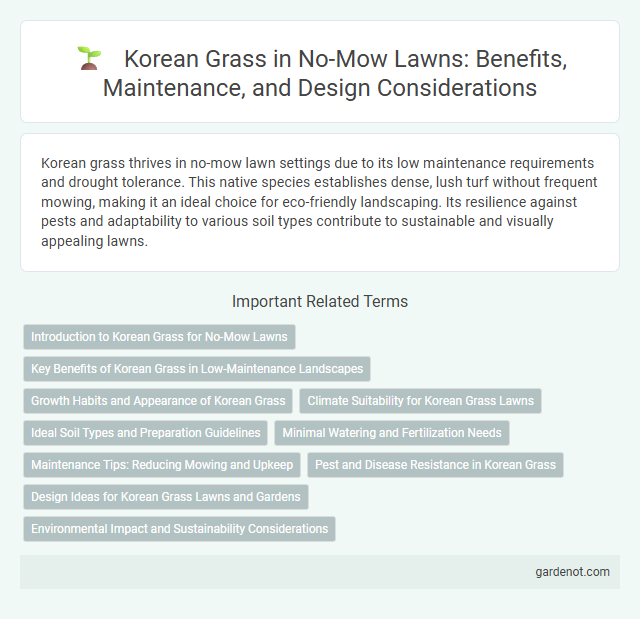Korean grass thrives in no-mow lawn settings due to its low maintenance requirements and drought tolerance. This native species establishes dense, lush turf without frequent mowing, making it an ideal choice for eco-friendly landscaping. Its resilience against pests and adaptability to various soil types contribute to sustainable and visually appealing lawns.
Introduction to Korean Grass for No-Mow Lawns
Korean grass (Zoysia japonica) is a popular choice for no-mow lawns due to its dense, slow-growing nature that minimizes the need for frequent mowing. This warm-season grass thrives in various soil types and exhibits strong drought tolerance, making it ideal for low-maintenance landscaping. Its fine texture and ability to form a thick carpet provide excellent weed suppression and a visually appealing, emerald-green turf throughout the growing season.
Key Benefits of Korean Grass in Low-Maintenance Landscapes
Korean grass thrives in low-maintenance landscapes due to its drought tolerance and minimal mowing requirements, reducing water consumption and labor costs. Its dense growth habit suppresses weed emergence, enhancing the lawn's overall health with less chemical intervention. The grass also exhibits strong resistance to pests and diseases, contributing to a sustainable and resilient turf solution.
Growth Habits and Appearance of Korean Grass
Korean grass (Zoysia japonica) exhibits a dense, creeping growth habit characterized by its strong rhizomes and stolons, which enable rapid lawn coverage and natural weed suppression. Its fine to medium-textured blades form a lush, deep green carpet that adapts well to heat, drought, and low mowing heights, making it an ideal low-maintenance turfgrass. The grass maintains a uniform appearance throughout the growing season, with excellent tolerance to foot traffic and minimal thatch buildup.
Climate Suitability for Korean Grass Lawns
Korean grass, known scientifically as Zoysia japonica, thrives in temperate climates with hot summers and cold winters, making it ideal for regions with seasonal temperature fluctuations. This grass species exhibits excellent drought tolerance and recovers quickly from frost damage, ensuring year-round lawn resilience. Its adaptability to well-drained soils and moderate shade conditions enhances its suitability for sustainable, low-maintenance no-mow lawns across diverse climate zones.
Ideal Soil Types and Preparation Guidelines
Korean grass thrives best in well-drained, loamy soils with a slightly acidic to neutral pH level between 6.0 and 7.0. Proper soil preparation includes thorough aeration and the incorporation of organic matter to improve soil structure and nutrient retention. Ensuring a firm yet loose seedbed is essential for optimal root development and long-term No-mow lawn success.
Minimal Watering and Fertilization Needs
Korean grass is an ideal choice for no-mow lawns due to its minimal watering requirements, thriving well in drought-prone areas with only occasional irrigation. Its natural resilience reduces the need for frequent fertilization, maintaining a healthy green appearance with low nutrient input. This turf grass supports sustainable landscaping practices by conserving water and minimizing chemical use.
Maintenance Tips: Reducing Mowing and Upkeep
Korean grass, particularly Zoysia japonica, thrives with minimal mowing due to its slow growth rate and dense turf formation. To reduce upkeep, maintain soil pH between 6.0 and 7.0, and ensure consistent watering of about 1 inch per week during dry periods. Fertilize lightly with a balanced nitrogen-phosphorus-potassium (NPK) ratio in early spring to promote healthy growth without encouraging excessive mowing.
Pest and Disease Resistance in Korean Grass
Korean grass exhibits strong pest and disease resistance, making it an ideal choice for no-mow lawns that require minimal maintenance. Its natural resilience against common lawn pests like grubs and fungal diseases reduces the need for chemical treatments, promoting an eco-friendly landscape. This robust resistance helps maintain a healthy, lush lawn throughout varying seasons without constant intervention.
Design Ideas for Korean Grass Lawns and Gardens
Korean grass, known for its lush texture and low maintenance, offers versatile design opportunities for no-mow lawns and gardens. Incorporating Korean grass creates soft, green carpet-like surfaces ideal for minimalist landscapes, shaded areas, and naturalistic garden designs. Its drought tolerance and slow growth make it perfect for eco-friendly, sustainable outdoor spaces with reduced mowing requirements.
Environmental Impact and Sustainability Considerations
Korean grass varieties, such as Zoysia japonica, are highly valued for no-mow lawns due to their low water requirements and natural resistance to pests, reducing the need for chemical fertilizers and pesticides. Their dense growth habit minimizes soil erosion and enhances carbon sequestration, contributing to improved air quality and climate change mitigation. Sustainable maintenance of Korean grass supports biodiversity by providing habitat for beneficial insects while conserving significant energy compared to traditional mowed lawns.
Korean grass Infographic

 gardenot.com
gardenot.com